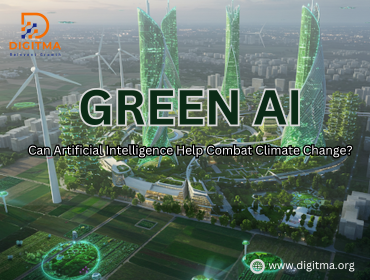
Green AI: Can Artificial Intelligence Help Combat Climate Change?
In a world where climate change is causing serious problems like rising sea levels, extreme weather, and loss of plants and animals, technology is being used to both help and hurt the environment. One exciting development is called Green AI. Green AI uses artificial intelligence (AI) to help protect the environment. But the big question is: Can AI really help stop climate change, or does it use so much energy that it ends up hurting the planet?

What is Green AI?
Green AI is a way of using artificial intelligence in a way that helps the environment. Regular AI uses a lot of energy, but Green AI focuses on using less energy and being eco-friendly. For example, training a large AI model can create as much pollution as five cars in their lifetime. That’s why scientists and tech companies are working to make AI both smart and better for the planet.
The Beginning of Green AI
AI has been around since the 1950s when scientists first tried to make machines think like humans. Over time, AI became super useful in things like medicine, money, and travel. However, as AI got smarter, it also started using more energy. Huge data centers, where AI is trained, use a lot of electricity. Around 2019, researchers started thinking about how to make AI more eco-friendly, and that’s when Green AI became important.
Can AI Help the Environment?
Even though AI uses a lot of energy, it can also help with climate change. For example, AI can help save energy by predicting when we will need power, reduce waste in factories, and help predict extreme weather events. Companies like Google have already used AI to make their data centers use less energy. Plus, AI can help scientists understand the weather better and give important information to people who make decisions about climate change.
How Green AI Helps the Environment
Green AI is helping in many ways:
- Energy Saving: AI can help use renewable energy like solar and wind in the best way possible. For example, energy use can be reduced through AI’s smart predictions.
- Farming: AI helps farmers use less water and grow more crops by studying things like weather and soil. This helps the environment by conserving resources.
- Weather Forecasting: AI can make weather predictions more accurate, which helps people prepare for disasters like floods or storms. More accurate forecasting leads to better planning.
- Reducing Pollution: AI can help companies reduce their pollution by making transportation and shipping more efficient. Less pollution means a cleaner planet.
While Green AI has a lot of benefits, it still uses energy, so it’s important to make sure that the energy used by AI is as low as possible.
How Green AI is Used in Different Areas
Green AI is being used in several ways to help the planet:
- Energy: AI is used to manage renewable energy like solar and wind. Companies like Siemens use AI to predict energy needs and make sure we use energy wisely.
- Farming: AI-powered drones help farmers track weather, soil, and crops. This means they don’t have to use as much water or chemicals, which is better for the environment.
- Transportation: AI helps make transportation more efficient. For example, UPS uses AI to figure out the best delivery routes, saving fuel. Self-driving cars also help cut down on pollution.
- Climate Monitoring: AI helps scientists track changes in the environment, like melting ice or deforestation, by analyzing satellite data.
- Smart Cities: Some cities use AI to reduce traffic and pollution. For example, in Singapore, AI helps manage traffic, while in Barcelona, it helps collect trash more efficiently.
What’s Important to Think About With Green AI?
Green AI can be great, but it also raises some important questions:
- Energy Use: Even though Green AI helps the environment, making AI models still uses a lot of energy. It’s important to find ways to reduce this.
- Privacy: AI uses lots of data, so it’s important to make sure people’s private information is safe.
- Fairness: Green AI should be available to everyone, not just rich countries or big companies. Everyone should have a chance to use AI to fight climate change.
- Jobs: As AI takes over certain jobs, some people might lose work. But it can also create new jobs in things like making AI or managing the environment.
What Can We Do to Make AI Better for the Planet?
There are a few things we can do to make Green AI even better:
- Create Energy-Efficient AI: Scientists should work on making AI use less energy by finding better ways to create AI models. This can be done through energy-saving techniques.
- Use Clean Energy: Tech companies should power their computers with renewable energy like solar and wind. Companies like Microsoft are already trying to use only clean energy by 2030.
- Be Transparent: AI companies should be clear about how their systems work and how they use data. This helps build trust.
- Work Together: Governments, businesses, and researchers need to work together to create AI that fights climate change. By sharing knowledge, we can help the whole world.
- Invest in Green AI: It’s important to invest money into research that makes AI more eco-friendly. This way, we can make faster progress in developing Green AI.
Real Examples of Green AI
Here are some cool examples of Green AI in action:
- Google DeepMind: Reduced energy use in data centers by 30% using AI-powered cooling systems.
- IKEA: Uses AI to reduce waste and emissions in their supply chain.
- The Ocean Cleanup: Uses AI to clean up plastic waste from the ocean.
- Wind Power: Companies like GE use AI to improve the efficiency of wind turbines.
Policy and Global Cooperation
For Green AI to reach its full potential, governments and global organizations must support it. Laws should be made that encourage using AI in ways that help the environment. Projects like Microsoft’s “AI for Earth” help fund research to protect the planet using AI. Working together, countries can speed up the development of Green AI and share resources to fight climate change.
Education is also key. By teaching young people about Green AI, we can make sure that the next generation of AI experts cares about the planet. Public awareness is important too—people need to know how AI affects the environment, both good and bad.
Conclusion
Green AI is a powerful tool in the fight against climate change. By helping save energy, improving farming, predicting weather, and reducing pollution, AI can make a real difference. However, we need to ensure it’s done responsibly. By making AI smarter and more eco-friendly, we can create a better future for our planet.


